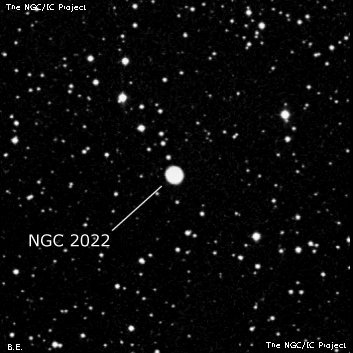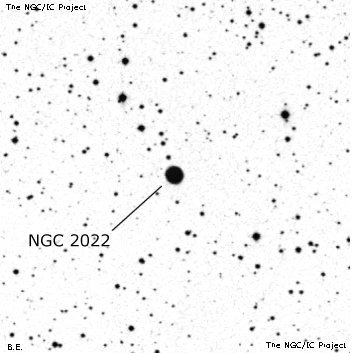NGC/IC Project Restoration Effort
(This is a very very beta version)
NGC2022


Basic Information
Location and Magnitude
Right Ascension: 5:42:6.2
Declination: +9:5:12
Constellation: ORI
Visual Magnitude: 11.6
Historic Information
Discoverer: Herschel W.
Year of discovery: 1785
Discovery aperture: 18.7
Observational
Summary description: planetary, pB, vS, vlE
Sub-type: PN
Steve's Notes
=====
NGC 2022
48" (2/21/12): at 488x, this bright, double-shell planetary contains a bright oval ring oriented SSW-NNE, ~23"x18". The annulus is fairly thin with a relatively large, darker central hole, though the contrast is fairly low. At the exact center is a faint central star (close to 16th mag?). The ring has an irregular surface brightness; slightly brighter at the ends of the major axis, particularly the SW end (knot or thicker?), and slightly fainter along the minor axis. Surrounding the ring is a fainter and rounder outer shell, ~30" diameter. The outer shell was surprisingly prominent and exhibited a pinkish hue.
24" (1/25/14): at 500x appeared as a fairly bright knotty annulus, slightly elongated SW-NE with fascinating structure. The rim was clearly brighter along an ~200¡ arc running from the southwest counterclockwise to the northeast. Very small brighter knots were definite at the SW and NE ends and perhaps a slight brightening at the NW edge. In general, though, the rim appeared mottled and sparkling though clearly dimmer along the southeast side, giving a "C" appearance. At 750x, the darker center was also irregular in surface brightness and occasionally, an extremely faint central star sparkled.
18" (2/24/06): at 220x appeared moderately bright, fairly small, round, ~25" diameter, very slightly elongated, irregularly lit and brighter along the western half of the rim giving a "C" appearance. A faint sparkle is occasionally visible on the WSW edge of the rim and images show this may be a faint superimposed star or knot in the planetary. 320x provides an excellent view with the planetary weakly annular and the rim a bit dimmer on the SE side. At 435x, the shape is slightly elongated SW to NE, ~27"x22" with a mottled interior and a brighter rim, particularly along the western half. The appearance is quite patchy at 565x and the sparkle on the SW end is still evident. The central star was not seen at any power. Ced 59 (surrounding FU Orionis) lies 48' due east.
17.5" (2/2/02): immediately picked up at 100x as a very small, bluish-gray "egg" of fairly high surface brightness. Good contrast gain with OIII filter. At 380x (unfiltered), it appeared as fairly bright, clearly elongated SSW-NNE, ~27"x20". The surface brightness was irregular or mottled with a slightly brighter rim and darker center giving a weakly annular appearance. The rim seems to have a couple of slightly brighter spots and the ends of the minor axis are slightly dimmer. No sign of a central star.
17.5" (12/8/90): fairly bright, slightly elongated 4:3 ~SSW-NNE, about 30" diameter. Appears slightly annular at 412x with a brighter rim. No central star seen at this power.
13": moderately bright, high surface brightness. � No internal structure was visible.



